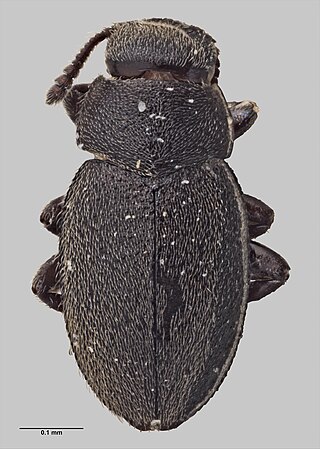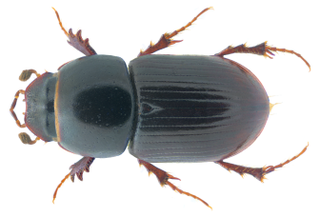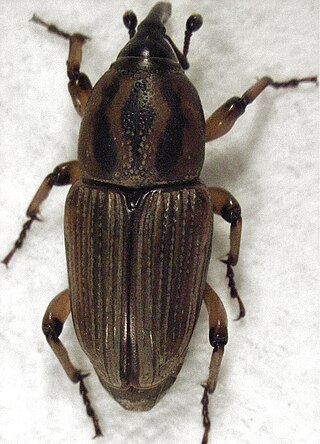
Fullmetal Alchemist is a Japanese manga series written and illustrated by Hiromu Arakawa. It was serialized in Square Enix's shōnen manga anthology magazine Monthly Shōnen Gangan between July 2001 and June 2010; the publisher later collected the individual chapters in 27 tankōbon volumes. The steampunk world of Fullmetal Alchemist is primarily styled after the European Industrial Revolution. Set in a fictional universe in which alchemy is a widely practiced science, the series follows the journey of two alchemist brothers, Edward and Alphonse Elric, who are searching for the philosopher's stone to restore their bodies after a failed attempt to bring their mother back to life using alchemy.

Myxophaga is the second-smallest suborder of the Coleoptera after Archostemata, consisting of roughly 65 species of small to minute beetles in four families. The members of this suborder are aquatic and semiaquatic, and feed on algae.

Winry Rockbell is a fictional character from Hiromu Arakawa's Fullmetal Alchemist manga series and its adaptations. Winry is a teenage mechanic who often spends time with the central characters, brothers Edward and Alphonse Elric, who are childhood friends of hers. Specializing in mechanical repair, specifically prostheses called automail, Winry services Ed's replacement arm and leg. Originally meant to be introduced in the series' first chapters due to its lack of female characters, some of Winry's traits are based on Arakawa's own life. In the first anime adaptation, Fullmetal Alchemist, Winry is voiced by Megumi Toyoguchi in Japanese and by Caitlin Glass in the English version. In the second anime adaptation, Fullmetal Alchemist: Brotherhood, she is voiced by Megumi Takamoto in Japanese, with Glass reprising the role in English.
Clinidium grimaldii is a species of ground beetle in the subfamily Rhysodinae. It was described by Ross Bell & J.R. Bell in 2009 and named after entomologist David Grimaldi. The description was based on a male specimen originating from Oligo–Miocene amber from the Dominican Republic.

Fullmetal Alchemist is a Japanese anime television series loosely adapted from the original manga series of the same name by Hiromu Arakawa. Comprising 51 episodes, it was produced by the animation studio Bones for Mainichi Broadcasting System and Aniplex, and directed by Seiji Mizushima. It was broadcast on MBS in Japan from October 2003 to October 2004.

Hyphalus wisei is a species of intertidal beetle endemic to New Zealand.
Cyclocephala nodanotherwon is a species of rhinoceros beetle in the scarab family. It has only been found in Amazonas, Brazil. Brett C. Ratcliffe described and named the species in 1992.

Calamosternus granarius is a species of dung beetle found with a widespread distribution.
Harmatelia bilinea, is a species of firefly beetle endemic to Sri Lanka.
Arixyleborus mediosectus, is a species of weevil found in India, Sri Lanka, Cambodia, Myanmar, Philippines, Malaysia, Indonesia: Sumatra and Vietnam.

Sphenophorus brunnipennis is a beetle in the Dryophthoridae family.

Mecodema crenicolle is an endemic species of ground beetle from New Zealand.
Sceloenopla octopunctata, is a species of leaf beetle found in India and Sri Lanka.

Caccothryptus larryi is a species of minute marsh-loving beetle in the subfamily Limnichinae. The species was described alongside five other Caccothryptus species by Natural History Museum entomologist Keita Matsumoto in 2021, using specimens gathered in 1953 by Harry George Champion in Haldwani, India. Both of the c. larryi specimens featured genital structures distinct from Champion's initial classification of C. ripicola. The species was named for Larry, the Chief Mouser to the Cabinet Office at the British Prime Minister's residence at 10 Downing Street.

Caccothryptus tardarsauceae is a species of minute marsh-loving beetle in the subfamily Limnichinae. The species was described alongside five other Caccothryptus species by Natural History Museum entomologist Keita Matsumoto in 2021, using a male specimen gathered in 1953 by Harry George Champion in Haldwani, India. One of Champion's specimens was distinguished from its initial classification of C. ripicola due to distinct genital structures. The species was named for Tardar Sauce, also known as Grumpy Cat, a pet cat which had become an internet celebrity prior to her death in 2019.

Caccothryptus brendelli is a species of minute marsh-loving beetle in the subfamily Limnichinae. The species was described alongside five other Caccothryptus species by Natural History Museum entomologist Keita Matsumoto in 2021, using specimens gathered by Martin J. D. Brendell at Kathmandu, Nepal in 1983. One of Brendell's specimens were distinguished from Caccothryptus testudo due to distinct genital structures and labeled C. brendelli after Brendell.

Caccothryptus championi is a species of minute marsh-loving beetle in the subfamily Limnichinae. The species was described alongside five other Caccothryptus species by Natural History Museum entomologist Keita Matsumoto in 2021, using specimens gathered in 1953 by Harry George Champion in Haldwani, India alongside an earlier 1925 specimen collected nearby. Like the other Caccothryptus species described by Matsumoto, it was distinguished from its original classification of C. ripicola due to differences in the shape of its genitalia. Twenty-seven specimens from the British Natural History Museum collection were identified with C. championi, named after Champion.

Caccothryptus abboti is a species of minute marsh-loving beetle in the subfamily Limnichinae. The species was described alongside five other Caccothryptus species by Natural History Museum entomologist Keita Matsumoto in 2021, using specimens gathered in 1953 by Harry George Champion in Haldwani, India alongside an earlier 1925 specimen collected nearby. Like the other Caccothryptus species described by Matsumoto, it was distinguished from its original classification of C. testudo due to differences in the shape of its genitalia. One specimen collected by Champion was identified as the holotype for C. abboti and named for English radio presenter Nick Abbot.
Caccothryptus yunnanensis is a species of minute marsh-loving beetle in the subfamily Limnichinae. The species was described in 2018 by enomologist Hiroyuki Yoshitomi. Although part of the species group C. testudo, it is related to the C. compactus species C. chayuensis) and C. thai due to serrae due to their shared small notches along the median lobe. It is distinguished from these due to its straight parameres, which are curved in C. chayuensis and C. thai. C. yunnanensis specimens were collected by Yu-Tang Wang across the Chinese provinces of Guizhou and Yunnan, the latter of which gave the species its name. It is almost entirely black in coloration, except for dark and light brown in its antennae and legs. It has an average length of around 5 mm. The holotype of C. yunnanensis is a male collected in Xima, Yunnan in 2014.
Caccothryptus is a genus of minute marsh-loving beetle in the subfamily Limnichinae. The genus was first described by entomologist David Sharp in 1902, with C. compactus as the type species.













